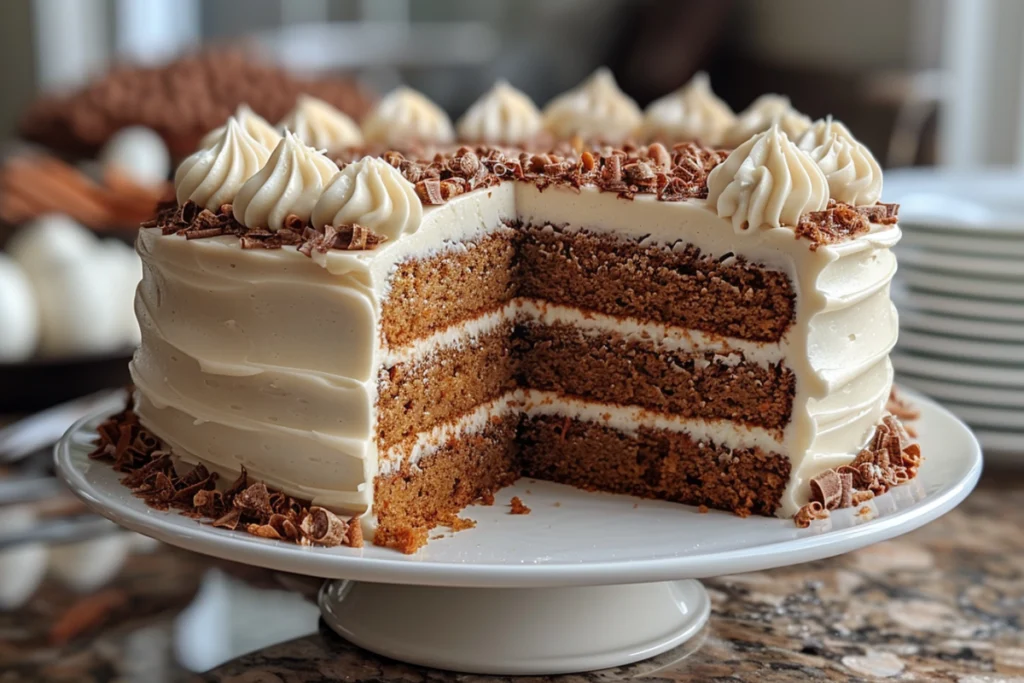Carrot cake is an iconic dessert that blends the natural sweetness of carrots with the warmth of spices, creating a dessert that is both rich and moist. Often topped with luxurious cream cheese frosting, this cake strikes the perfect balance between savory and sweet. Whether you’re preparing it for a holiday, birthday, or just to satisfy your sweet tooth, this guide will help you make the perfect carrot cake.
We’ll walk through the history, the best ingredients to use, variations of the recipe, and expert tips on baking, frosting, and decorating. You’ll also find solutions for common problems, ensuring your cake turns out beautifully every time.
Introduction to Carrot Cake
Carrot cake has an interesting history that dates back to medieval Europe, where carrots were often used in desserts as a substitute for expensive sweeteners like sugar. During World War II, carrot cake became especially popular in the UK due to rationing. For another great carrot cake recipe and more baking tips, check out Sally’s Baking Addiction’s Carrot Cake Recipe.
Why is carrot cake so loved? It’s all about balance—the sweet, earthy flavor of carrots, the warmth from spices, and the moist texture that practically melts in your mouth. Carrots not only add moisture but also provide a subtle sweetness and beautiful color.
The beauty of carrot cake lies in its versatility. You can add nuts, fruits like pineapple or raisins, or even swap the frosting for a lighter alternative. Whether you make it into cupcakes or a large layered cake, there’s always a way to customize this classic treat.
Key Ingredients in a Carrot Cake
To create the perfect carrot cake, you need to start with high-quality ingredients. Each plays a significant role in the texture and flavor of your cake:
- Carrots: Freshly grated carrots are essential. Avoid using pre-shredded carrots as they tend to be dry. The moisture from the freshly grated carrots ensures that your cake stays soft and tender.
- Spices: The trio of cinnamon, nutmeg, and ginger is what gives carrot cake its signature flavor. You can also add a pinch of cloves for an extra punch of warmth.
- Sweeteners: Traditionally, granulated sugar or brown sugar is used. Brown sugar adds more moisture and a slight caramel undertone. If you prefer natural sweeteners, you can use maple syrup or honey, but you’ll need to adjust the liquid ingredients slightly.
- Flour: All-purpose flour works well, but for a healthier twist, you can use whole wheat or even gluten-free flour without losing the integrity of the cake.
- Fat: Oil is the preferred fat in most carrot cake recipes, as it helps to create a moist texture. Canola or vegetable oil is commonly used, but for added flavor, try coconut oil.
- Add-ins: To give your cake extra texture and flavor, you can add chopped walnuts, pecans, raisins, or crushed pineapple. These additions bring bursts of sweetness and a bit of crunch.
For more on how ingredients affect the final product, read the history of carrot cake, which details how this iconic cake has evolved over time.
Step-by-Step Process to Bake a Carrot Cake
Step 1: Prepare the Ingredients
Begin by grating your carrots (you’ll need about 2 cups for a standard recipe). Next, measure out the dry ingredients: flour, baking soda, cinnamon, nutmeg, ginger, and a pinch of salt. Sift the dry ingredients together to ensure there are no lumps and that the spices are evenly distributed.
Step 2: Mix Wet Ingredients
In a separate bowl, whisk together the sugar and oil until smooth. Add the eggs one at a time, beating well after each addition. The wet ingredients should be light and slightly fluffy. Adding eggs gradually helps incorporate more air, leading to a lighter cake.
Step 3: Combine Wet and Dry Mixtures
Slowly add the dry ingredients to the wet mixture, stirring just until incorporated. Over-mixing will make the cake dense, so be gentle here. Once the batter is smooth, fold in your freshly grated carrots, and any optional add-ins like raisins or crushed pineapple.
Step 4: Bake the Cake
Pour the batter evenly into two 9-inch greased and floured cake pans. Bake in a preheated oven at 350°F (175°C) for 30-35 minutes. Rotate the pans halfway through to ensure even baking. To check if the cakes are done, insert a toothpick in the center—if it comes out clean, your cake is ready. Let the cakes cool for about 10 minutes in the pans before transferring them to a wire rack to cool completely.
Variations of Carrot Cake
There are countless ways to customize your carrot cake recipe to suit your preferences:
- Gluten-Free Carrot Cake: Swap out regular flour for a gluten-free blend that includes xanthan gum for structure. Many people who are gluten-sensitive can still enjoy a moist carrot cake with this easy substitution.
- Vegan Carrot Cake: Replace the eggs with a mixture of ground flaxseed and water (1 tbsp of flaxseed + 3 tbsp of water per egg). You can also use plant-based milk and oils like coconut oil or almond milk.
- Carrot Cake Cupcakes: This batter can be easily adapted into cupcakes. Simply pour the batter into cupcake liners and bake for 18-22 minutes. They’re perfect for portion control or as a treat for children’s parties.
- Carrot Cake with Pineapple: For extra moisture and a tropical twist, add a half-cup of crushed pineapple to the batter. Be sure to drain the pineapple well before adding it to avoid excess liquid.
If you’re looking for more unique takes on carrot cake, consider pairing it with exotic spices like cardamom or adding a layer of coconut frosting.
Cream Cheese Frosting: The Perfect Topping
The key to any good carrot cake is its cream cheese frosting. The tanginess of the cream cheese pairs perfectly with the sweet and spiced cake. Here’s how to make the perfect frosting:
Ingredients:
- 8 oz cream cheese (room temperature)
- ½ cup unsalted butter (room temperature)
- 4 cups powdered sugar, sifted
- 1 teaspoon vanilla extract
Instructions:
- In a large bowl, beat the cream cheese and butter until smooth.
- Gradually add the powdered sugar, beating on low speed to avoid a sugar cloud.
- Once the sugar is incorporated, increase the speed and add the vanilla extract. Beat the frosting until it’s light, fluffy, and creamy.
For a variation, you can add a hint of lemon zest or orange zest to brighten the flavor, or swap out vanilla extract for almond extract.
Storage Tips: Keeping Your Cake Fresh
To enjoy your cake at its freshest:
- Refrigeration: Since cream cheese frosting is perishable, store your cake in the refrigerator. It will keep well for 3-4 days when stored in an airtight container.
- Freezing: If you plan to freeze the cake, wrap it tightly in plastic wrap and then in aluminum foil. It can be frozen for up to 3 months. When you’re ready to serve it, let the cake thaw in the refrigerator overnight, and bring it to room temperature before slicing.
- Reviving Leftover Cake: To refresh a slightly stale cake, warm it briefly in the microwave (without frosting) or let it sit at room temperature for a while before serving.
FAQs: People Also Ask
How can I make my carrot cake even more moist? To enhance the moisture of your carrot cake, you can add crushed pineapple or applesauce to the batter. Both ingredients add extra moisture and flavor.
What can I use instead of oil in carrot cake? If you prefer not to use oil, you can substitute it with melted coconut oil or unsweetened applesauce for a lighter version. However, using oil will still yield the best moisture retention.
Can I use a different type of flour for carrot cake? Yes, you can use different types of flour, such as whole wheat flour or gluten-free flour blends. Keep in mind that substitutions may affect the texture and flavor of the cake.
How do I prevent my carrot cake from being too dense? To avoid a dense carrot cake, ensure that you do not overmix the batter and use fresh baking powder. Additionally, sifting your flour can help incorporate air into the mix.
Can I add other fruits or vegetables to my carrot cake? Yes, you can add other fruits like crushed pineapple, apples, or raisins, and vegetables like zucchini to your carrot cake for extra flavor and moisture.
How long can carrot cake be stored at room temperature? Carrot cake can be stored at room temperature for up to two days if it is unfrosted. If frosted, it should be refrigerated to keep the frosting fresh.
What’s the best way to thaw frozen carrot cake? The best way to thaw frozen carrot cake is to transfer it from the freezer to the refrigerator and let it thaw overnight. This method ensures that the cake remains moist and retains its texture.
Can I make carrot cake in advance for a party? Yes, you can make carrot cake in advance. Bake and cool the cake, then store it in an airtight container at room temperature if unfrosted, or refrigerate if frosted. For the best taste, let it come to room temperature before serving.



